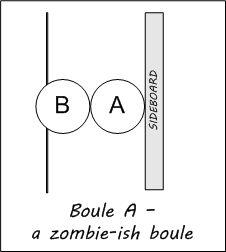
Petanque jack (hidden by tree)
[updated 2018-12-17]
In games played on an open terrain, sometimes the jack is hit and knocked behind a tree or rock so that it can’t be seen from the circle. When that happens, Article 9 of the FIPJP rules is relevant. It says that the displaced jack is dead if it is not visible from the circle. This seems like a simple rule, but there can be problems when trying to apply it.
Who decides whether or not the jack is visible from the circle?
Article 7 of the FIPJP rules says that the jack must be visible to a player whose feet are placed at the extreme limits of the interior of the circle and whose body is absolutely upright. In case of a disagreement about this matter, the umpire decides if the jack is visible.
Suppose Alan is in the circle, ready to throw. But he can’t see the jack, which has been knocked behind a large rock on the terrain. So the jack is dead. What could be simpler?
Suppose, however, that Bill steps into the circle, to verify that the jack really cannot be seen from the circle. Bill says that he can see the jack easily. Is the jack dead?
The FIPJP rules, which are designed for use in umpired competitions, say that Alan and Bill should call in an umpire to decide. But this is a friendly, informal game; there is no umpire. Who decides? The FIPJP rules have no answer to this question.
Suppose, however, that an umpire is available. He is called in and says that he can see the jack, so the jack is not dead. But that leaves Alan with a problem, because he still cannot see the jack. Oh, did I mention that Alan is playing from a wheelchair? His head is much lower than the umpire’s head, which is why the umpire could see the jack, but Alan could not. Shouldn’t the umpire take this fact into account when deciding whether or not the jack is visible? Mike Pegg’s answer is NO. “[This rule] may put the disabled player at a disadvantage but when entering the event they would know what the rules are.”[1]
The rules of Petanque Libre (PL) are designed for use in non-umpired games, and PL gives a different answer. Under PL, “If the jack is moved, both teams are responsible for agreeing that the jack in its new location is visible from the circle. If a team has a player who has unplayed boules and that player cannot see the jack while standing in the circle, the team will not agree that the jack is visible; otherwise the team will agree that the jack is visible.” So in this case, when playing by the rules of Petanque Libre, when the jack was hit and knocked behind the stone, Alan’s team would challenge the visibility of the jack. Since one of the team’s members (Alan) could not see the jack from the circle, his team would not agree that the jack is visible and the jack would be declared dead.
What happens when the jack is knocked out of sight by the last boule?
Suppose the jack is knocked behind a tree by the last boule to be played. Nobody is going to throw another boule. So it seems like it shouldn’t matter whether or not the jack is visible from the circle. Is the jack dead?
The answer that an FIPJP umpire will give is— “Article 9 says that if the jack is shot out of sight, it is dead. It doesn’t say that the jack is dead unless there are no more boules left to be played. So YES, the jack is dead.” The problem with this answer is that there is no player in the circle to decide whether or not he can see the jack, and in an informal game there is no umpire to make the decision.
The Petanque Libre position on this question is that the visibility rule exists to insure that no player must throw toward a jack that he cannot see. But after all boules have been thrown, questions about the visibility of the jack are moot. Therefore— “After all boules have been thrown, neither team may challenge the visibility of the jack.”
Footnotes
[1] See Mike’s answer to the question posed by Brian Harris on “Ask the Umpire”, 2017-04-26 www.facebook.com/groups/128791213885003/permalink/1212752685488845/





 If the thrown boule changed nothing on the ground, the boule is simply removed. On the other hand, if the thrown boule DID change something on the ground, Article 22, Displaced boules applies.
If the thrown boule changed nothing on the ground, the boule is simply removed. On the other hand, if the thrown boule DID change something on the ground, Article 22, Displaced boules applies.